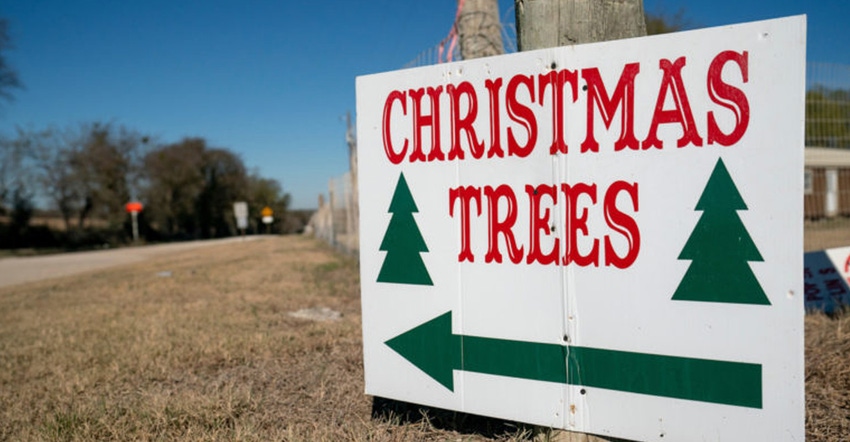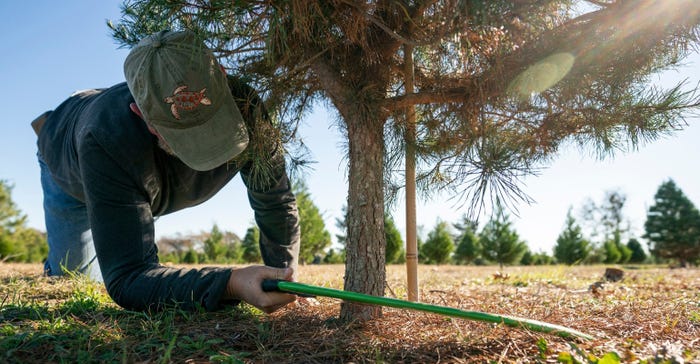
There are plenty of options for decorative trees during the holiday season. Texas A&M AgriLife experts have tips for a live or cut Christmas tree, including an increasingly popular option — live container-grown or balled-and-burlap trees.
Oregon and North Carolina account for 51% of harvested Christmas trees annually, with almost 3.4 million and 4.3 million trees, respectively. But tree farms in Texas have increased over recent years both as a destination experience and supplier of shipped and locally grown trees.
Fraser, Douglas and balsam firs are popular tree varieties shipped from other parts of the country. Eastern red cedar, Virginia and Afghan pine, and Arizona, Leyland and Carolina sapphire cypress trees are suited for growing in Texas climates. These can be bought locally as a cut tree or in a container.
Potted Christmas tree tips
Mike Arnold, Texas A&M AgriLife Research landscape horticulturist in the Department of Horticulture Sciences and director of the Gardens at Texas A&M University, Bryan-College Station, said there is a growing trend during the holidays to decorate potted live trees. Potted trees, unlike cut trees, can be planted into a landscape after their decorative use.
“It’s a green-friendly alternative,” he said. “You’re putting back instead of removing, and I think a lot of people are drawn to that, the experience of planting a tree and having a good-looking evergreen in the landscape.”
There are two major considerations for potted plants, Arnold said – choosing the right tree variety for local growing conditions and maintaining the tree’s dormancy while using it to decorate.
Being mindful of a tree’s dormancy is important to avoid post-planting freeze damage during the coldest winter months, Arnold said. The tree should be kept indoors for as short a time as possible and preferably outdoors or in a transitional space that remains cooler.
Arnold also recommends using LED lights for decorating as these will not heat up as much as older bulbs and potentially damage the tree.
“My recommendation is to have the tree indoors a few days before Christmas and then plant it outdoors on, or soon after, New Year’s Day, so a week to 10 days because you would likely run into problems beyond that,” he said. “The concern when bringing a container tree into your home is that the tree thinks it is spring and will break bud and sap will begin moving in stems. That spring-like activity can lead to damage in freezing temperatures.”
Arnold said buyers should consult AgriLife Extension agents in their county or nursery professionals to discuss variety options that are adapted for local conditions and the best location for the tree in the landscape according to growth habit and sunlight requirements.
The root ball should be kept moist because dry environments can cause moisture stress, Arnold said. When planting, trees should be planted with the base level or slightly above ground level to avoid pooling water.
Arnold said rosemary makes a good alternative Christmas tree, and that Norfolk Island pines and weeping fig trees, which are tropical trees, can be used as indoor plants after the holidays are over.
“You don’t have to have a conifer,” he said. “Other trees and house plants can be used as temporary decorative trees.”
Caring for cut trees
Greg Grant, Texas A&M AgriLife Extension Service horticulture agent, Smith County, said Christmas tree shoppers should focus on choosing the right tree and maintaining it correctly for the duration of its time as a decoration.
“One thing I’ve noticed over the last few years is that people are putting out Christmas decorations earlier and earlier, and people just need to remember that cut trees typically only last three to four weeks if they are cared for correctly,” he said.
 Christmas tree farms like Tim’s Trees provide fresh-cut options that typically last longer than those pre-cut and shipped from other states. (Texas A&M AgriLife photo by Laura McKenzie)
Christmas tree farms like Tim’s Trees provide fresh-cut options that typically last longer than those pre-cut and shipped from other states. (Texas A&M AgriLife photo by Laura McKenzie)
When picking a tree, Grant said to look for trees that are full and even without damaged spots and to choose the correct size for the space it will be placed. Buyers should look for signs of freshness in cut trees, such as whether the tree is dropping needles. Cut trees can be shipped long distances and may show signs of drying out.
For this reason, Grant recommends buying trees from local farms that allow shoppers to pick and cut their choice tree. Variety choices will be limited by region, but fresh cut trees will typically last longer than those cut and shipped.
“When it comes to freshness, local is best,” he said. “Tree farms have been gaining popularity and usually carry both shipped cut trees and live trees that are picked and cut. Buying a Christmas tree at places like that is usually about the experience, and it helps support local businesses.”
Extend your Christmas tree’s decorative life
To extend a cut tree’s use, Grant said trees should be recut upon arrival and placed in a 5-gallon bucket of water overnight. Make sure to cut the base square to the tree.
“Recutting is having the same effect as it does with cut flowers. You’re opening up the base so that it can take up water, which will improve the longevity,” he said. “And by placing it directly in a bucket of water overnight, you’re rehydrating the tree before you place it in the stand.”
After the overnight soak, the tree should be placed in a stand with a full water reservoir in a location that is away from fire hazards like heaters and fireplaces or vents that will blow hot air on the tree and speed up drying. The reservoir should be checked daily and refilled before it goes dry.
Grant said LED lights should be used and turned off when not viewing the tree.
Cut trees cannot be replanted, but they can be useful beyond their decorative life, Grant said. Two of the best uses are as habitat enhancements for fish in ponds and mulch for gardens.
“Dropping them into a pond or off of a dock can provide good shelter for bait fish, which will make it a good fishing spot,” he said. “And a lot of municipalities and public works departments are providing disposal services. Some will chip or shred them to provide mulch for your garden.”
Christmas tree tidbits
Christmas tree varieties grow 1-2 feet per year and are typically mature for marketing in six to eight years. For every tree harvested, two to three seedlings are planted each spring.
The Scotch pine is the most popular Christmas tree variety, and balsam fir trees are the most fragrant.
The worst trees for allergy potential are pines and cedars, and artificial trees are best for people with allergies. They’re also the most fire-resistant option as well.
Cut and live tree varieties are mildly toxic to dogs and cats in that the tree oil can upset their stomach if they chew on the tree.
Source: is AgriLife TODAY, which is solely responsible for the information provided and is wholly owned by the source. Informa Business Media and all its subsidiaries are not responsible for any of the content contained in this information asset.
Read more about:
Christmas TreesAbout the Author(s)
You May Also Like




